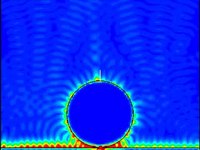
Photo from wikipedia
This paper presents the first theoretical framework that defines the electric infinitesimal structure model of electromagnetic waves. This model represents the electromagnetic fields by electric field components only. These components… Click to show full abstract
This paper presents the first theoretical framework that defines the electric infinitesimal structure model of electromagnetic waves. This model represents the electromagnetic fields by electric field components only. These components have a specific spatial arrangement that is responsible for exerting both the magnetic force and the electric force applied by the electromagnetic waves. There is no existing work that specifies this infinitesimal purely electric structure. Previous work considered electromagnetic waves to be formed by two types of fields, despite the belief that the magnetic field is an electric field in its origin. The model has been built by analyzing the changes in the flow of electric charges producing changing currents. These charges emit electric fields with disturbances spreading in the space to reflect the changes of charges position and speed inside current elements. These disturbances in the electric fields contain discontinuity points reflecting these changes. Applying Gauss’s law at these discontinuity points indicates the existence of electric charges, referred to as discontinuity charges. These spreading discontinuity charges electrically interact with static charges and current elements present at the crossing points in the space. This interaction produces forces on these charges and elements that are equivalent in magnitude and direction to the observed electric force and magnetic force exerted by electromagnetic waves. The relationship between these forces has been analyzed to obtain the formulas that govern them. These formulas are found to be exactly equivalent to Maxwell’s equations proving the validity of the proposed model. Moreover, this model is in alignment with the experiments of pair production phenomena, i.e., photons split to electron and positron, which indicate that photons may have embedded charges inside them. This work is important to help scientists in modeling the physical reality of photons and in better understanding the deeper physical process behind electromagnetic wave interactions.
Journal Title: IEEE Access
Year Published: 2021
Link to full text (if available)
Share on Social Media: Sign Up to like & get
recommendations!